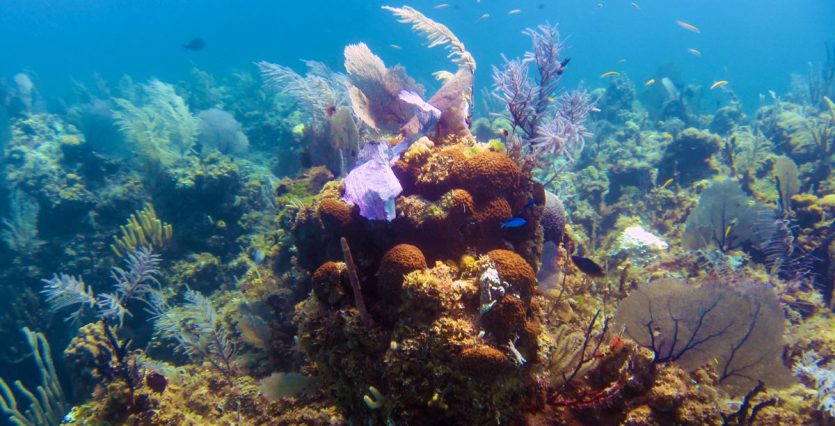Getting dive certified is something my husband, Tim, and I have talked about doing for the better part of at least 10 years now. We even ordered the books and had planned to do a diver certification course in Malta when we first moved to Europe. But life got in the way and after realizing that the Mediterranean and Adriatic don’t have coral reefs and the reef fish we love to look at, we just didn’t pursue it.
We have friends who had done their open-water dive certifications in the Bahamas, and they still gush about the experience. I’d visited a few months earlier, and the coral reefs were colorful and teeming with fish. I didn’t hesitate for even a second when the opportunity presented itself to head back to the Bahamas for our dive certification course.
Deep Water Cay, a private island and a world-class bonefishing lodge in Grand Bahama (deepwatercay.com), invited us to come try out their new NAUI Scuba Diver certification program. I was over-the-moon with excitement about getting open water certified.
Tim and I were literally off the boat and into the classroom thanks to a delayed flight. If you’re getting dive certified at Deep Water Cay, they will send you the course materials via mail prior to your trip. We didn’t have time to get the materials beforehand, but I’d highly recommend you do and study up. You can register and take the classroom part and the exam on NAUI’s website via their eLearning system.
After flying to the Bahamas from Italy and being jet-lagged, that afternoon was a mentally grueling day. Even worse, the view from the classroom was of the infinity pool with the swirls of sand bars peeking out of an aquamarine sea. We just wanted to be out there enjoying the water, but the classroom work was a necessary part in the journey to getting our dive certification. Seriously, get the materials before your dive certification trip.
After dinner, we made a pot of coff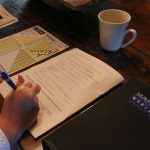 ee and did homework. I felt like I was back in university. We were preparing to take our exam in the morning, which we needed to pass in order to progress on to the skills learning in the pool. Thank God for my eidetic memory.
ee and did homework. I felt like I was back in university. We were preparing to take our exam in the morning, which we needed to pass in order to progress on to the skills learning in the pool. Thank God for my eidetic memory.
With passing scores, it was time to learn about all the equipment like the buoyancy compensator (BC), regulator and tank. That was the easy part; though it’s essential to pay close attention to the details, since one skill you have to demonstrate to receive your certification is that you can set up all your equipment properly. And seeing how all this stuff is what will keep you alive under the sea, you darn well want to be sure it’s done right.
With what felt like a million pounds on my back, we each took a giant stride into the pool and got used to swimming around on the surface with all that gear. It’s just about weightless in the water. No wonder divers hop in so quickly!
We learned and practiced skill after skill in the pool. From just getting the hang of long, deep breaths through the regulator to taking off our entire scuba setups underwater and putting it back on, we went through all the skills we would repeat on the four required dives to complete the open water certification. This included the mask clear, where you take your mask off, put it back on and clear all the water from it underwater. This was the one thing I worried I would completely freak out doing and that’s exactly what happened, though the guidance of our NAUI Instructor, Phillip Russell (NAUI 57738), I did manage to eventually do it in the pool.
When we headed out on our first open water dive, I could feel my stomach knotting up with nerves. I was completely comfortable underwater, except when it came to the mask retrieval and clearing. I had spent no less than a decade thinking about how this skill scared me beyond belief. But I was going to have to do it and demonstrate that I was comfortable doing it to continue the dive if I wanted to go back home as a certified diver.
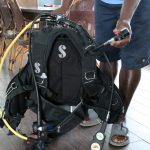 The boat bobbed up and down in the choppy water as I stood at the back with all my gear on. Tim was already descending down the guideline. The fear hit me, and I shook my head “no” as Phillip tried to coax me to take a giant stride. I had to sit and scoot my way down a few steps of the ladder and then just sort of flop in. Phillip told me we’d swim around and look at the fish until I was relaxed and then we’d start doing skills.
The boat bobbed up and down in the choppy water as I stood at the back with all my gear on. Tim was already descending down the guideline. The fear hit me, and I shook my head “no” as Phillip tried to coax me to take a giant stride. I had to sit and scoot my way down a few steps of the ladder and then just sort of flop in. Phillip told me we’d swim around and look at the fish until I was relaxed and then we’d start doing skills.
Okay, I could live with that plan.
Our first dive was at just 5 meters (17 feet) on a mostly sandy area where we could kneel on the bottom to do the skills like taking the regulator out of our mouth and putting it back in, retrieving the regulator by sweeping our arm to find it if it gets knocked out of our mouth, and the “evil” mask removal and replacement. Oddly, I had absolutely no problem taking the regulator out of my mouth — you know, the very thing that keeps you alive under the water — and tossing it over my shoulder while I slowly exhaled a few bubbles and retrieved my “lost” regulator.
But my heart would clutch with fear at the very thought of having to take my mask off underwater. I worried it would get snagged in my hair. I worried I wouldn’t be able to tell when my mask was clear and my contacts would float out of my eyes. I worried water would go up my nose.
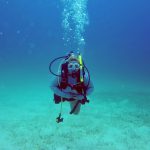
We practiced just clearing the mask, where you blow a long breath out your nose to break the seal and push out any water that might have gotten in the mask. But we held off on the mask retrieval, at least for now. Phillip gave us the signal to end the dive and slowly ascend up the line.
Just as we were disconnecting our used tanks from our BCs, the seasickness hit.
I was miserable as I hung over the side of the boat. It’s rare that I actually get seasick. So rare that the last time I actually threw up on a boat was on a hot boat ride from St. Maarten to St. Barts in 2007. My cheeks flamed red in embarrassment as tears streamed down them.
The salty air helped once we were moving and en route to our second dive site of the day. You need the four open water dives for certification; sitting even one out would have meant I wouldn’t be getting my certification. I was determined to make the second dive no matter how horrible I felt. That is, until the second wave of seasickness hit.
I hung crying and heaving over the side of the boat as Tim and Phillip descended down the line.
Finally feeling better, I just dove in the sea to stay cool in the water and be off the bobbing boat. Just as I was wishing there was a way to radio down and say I was good to go, Phillip popped up and asked if I wanted to do the dive. I hopped into my gear and was back in the water in seconds. It was so much better in the water; I didn’t feel sick at all.
The second dive was around a giant rock that descended down to a depth of 11 meters (35 feet), twice deeper than the first dive. Colorful fish swam in and out of the corals that were attached to the rock. I could have floated there blissfully watching the fish forever. I was relaxed and happy to be under the sea. Wanting to be down there so badly was motivating me to get through the mask retrieval skill.
We did more skills, this time practicing sharing air in case you’re out of air and need to use your dive buddy’s extra regulator. We got the hang of controlling buoyancy and hovering at 4.5 meters (15 feet) for the 3-minute precautionary safety stop during ascent.
That night I still worried over completing my mask retrieval skill. And when a storm rolled in late that night, I almost hoped our dives would be cancelled the next day. I had some serious anxiety over this whole mask thing.
The water was actually calmer despite the stormy start to the day. The dive started out well, and we did some skills immediately after our descent. I even just grabbed my own regulator and put it back in my mouth when Tim’s octopus regulator was a little too large to comfortably fit in my mouth. Phillip gave me underwater high fives at staying calm.
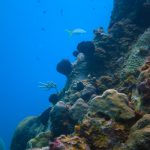 I felt like I was ready to just get the mask retrieval skill over with after swimming around and looking at the reef for a bit. I motioned to Phillip that I was ready to do it. We both knelt on the bottom and after a few long, calming breaths I closed my eyes and took my mask off. I sat breathing in and out with the mask in my hand for a little bit and then started to put it back on.
I felt like I was ready to just get the mask retrieval skill over with after swimming around and looking at the reef for a bit. I motioned to Phillip that I was ready to do it. We both knelt on the bottom and after a few long, calming breaths I closed my eyes and took my mask off. I sat breathing in and out with the mask in my hand for a little bit and then started to put it back on.
Everything that I worried would go wrong seemed to happen all at once. The mask didn’t go back on right, and I got the nose all folded up under it. Phillip helped me get it adjusted, and I started blowing out my nose to clear out the water. He tapped me when the mask was clear, and I could open my eyes, but I was in a full-blown anxiety attack already.
It felt like one of those scenes in movies when you see someone drowning. I could barely see Phillip kneeling in front of me. There had been a wall of coral just a few feet behind him and I couldn’t see it at all. Everything was just green with particles swirling around. I gave him the signal I wanted to go up.
If there was a way you could beg and plead with hand signals, I figured it out in this moment. Phillip conceded and held my hand to force me to slowly ascend. We even made the 3-minute safety stop. But I hadn’t calmed down. I could see just fine by this point but I just wanted to go back to the boat. Poor Tim didn’t even know what had happened. It wasn’t until Phillip descended again that Tim realized I’d had a panic attack and wasn’t coming back.
I just thought I was done at this point. I was embarrassed I’d panicked and was in tears well beyond when Tim and Phillip finished the dive.
“It’s going to break my heart to not certify you,” Phillip told me.
We went to a beach for lunch, and I calmed down. Sitting on that beach, I decided I was going to kick this fear. I could sit there under the water without the mask on, so what was my problem with putting it back on? I honestly didn’t know. I truly could not explain it even talking through it with Phillip, who I’ve got to say, has the patience of a saint.
I knew it was totally unconventional, but I asked Phillip to come hold my snorkel up while holding me under the water. I wanted to practice taking my mask off and putting it back on. We sat in about three feet of water with the boat blocking us from a fast moving current while I worked through my fear. I’d even sit under the water without a mask just breathing through my snorkel without a care in the world as Phillip held the top of it out of the water.
I finally figured out doing this that it was the water dripping off my face and from the inside of my mask that was the trigger for me. I didn’t like the sensation and it took about 30 seconds for my eyes to clear the salty drips out to be able to see again. Once I knew what to expect, I repeated the mask retrieval five more times without a problem. Phillip even had me put my scuba gear on and do it several more times with the regulator instead of the snorkel.
Seriously, he had the patience of a saint.
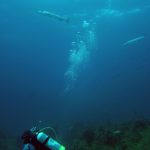
With a storm brewing, we quickly got to the second dive site. It was the best reef we’d dived yet. We swam around looking at reef fish, barracudas slowly swam around us, and I even spotted a lionfish, which I was super excited about.
When Phillip gave me the signal it was time to do my mask retrieval, for the first time in this whole process my heart didn’t feel like it
was beating so hard that it was about to jump out of my chest. I knew I had it, and Icalmly took the mask off, put it back on and cleared it. Unlike the first dive when I panicked myself into what Tim now calls my hysterical blindness, I blinked and waited for my eyes to clear. And then I went about the rest of the dive A-OK.
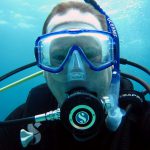
“I’m so proud of you!” Phillip told me.
Me too, Phillip. Me too. I clearly had to work through my fearin a way until I was calm and comfortable.
Both Tim and I earned our NAUI Scuba Diver certifications, though I’m not convinced I would have made it successfully through a group course where an instructor could not have given me the individual attention that Phillip did. There couldn’t have been a better place than Deep Water Cay, a secret diving sanctuary, for someone like me with fears, yet who so desperately wanted to dive.
================
Jennifer Dombrowski and Tim Davis operate Luxe Adventure Traveler (luxeadventuretraleler.com). Jennifer started her luxury travel business after Tim’s job transferred him to Italy in 2009. Now living in Bordeaux and continuing to build the business, they have so far visited more than 50 countries on four continents.


